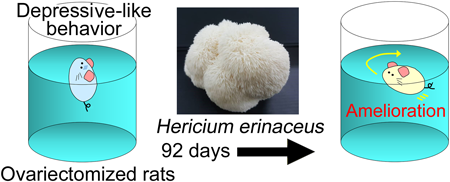- 著者
- Sangchai Yingsakmongkon Daisei Miyamoto Nongluk Sriwilaijaroen Kimie Fujita Kosai Matsumoto Wipawee Jampangern Hiroaki Hiramatsu Chao-Tan Guo Toshihiko Sawada Tadanobu Takahashi Kazuya Hidari Takashi Suzuki Morihiro Ito Yasuhiko Ito Yasuo Suzuki
- 出版者
- The Pharmaceutical Society of Japan
- 雑誌
- Biological and Pharmaceutical Bulletin (ISSN:09186158)
- 巻号頁・発行日
- vol.31, no.3, pp.511-515, 2008-03-01 (Released:2008-03-01)
- 参考文献数
- 30
- 被引用文献数
- 42 46
Using a plaque reduction assay, treatment of human influenza A viruses with the fruit-juice concentrate of Japanese plum (Prunus mume SIEB. et ZUCC) showed strong in vitro anti-influenza activity against human influenza A viruses before viral adsorption, but not after viral adsorption, with 50% inhibitory concentration (IC50) values against A/PR/8/34 (H1N1) virus, A/Aichi/2/68 (H3N2) virus and A/Memphis/1/71 (H3N2) virus of 6.35±0.17, 2.84±1.98 and 0.53±0.10 μg/ml, respectively. The plum-juice concentrate exhibited hemagglutination activity toward guinea pig erythrocytes. Its hemagglutination activity was inhibited by the monosaccharide N-acetylneuraminic acid and a sialoglycoprotein (fetuin), but not by the other tested monosaccharides (mannose, galactose, glucose and N-acetylglucosamine), suggesting the presence of a lectin-like molecule(s) in the Japanese plum-juice concentrate. Our findings suggest that the fruit-juice concentrate of Japanese plum may prevent and reduce infection with human influenza A virus, possibly via inhibition of viral hemagglutinin attachment to host cell surfaces by its lectin-like activity.
- 著者
- Azliza Mad Anuar Akira Minami Hiroshi Matsushita Kanako Ogino Kosei Fujita Hatsune Nakao Shota Kimura Vikineswary Sabaratnam Kaoru Umehara Yuuki Kurebayashi Tadanobu Takahashi Hiroaki Kanazawa Akihiko Wakatsuki Takashi Suzuki Hideyuki Takeuchi
- 出版者
- The Pharmaceutical Society of Japan
- 雑誌
- Biological and Pharmaceutical Bulletin (ISSN:09186158)
- 巻号頁・発行日
- vol.45, no.10, pp.1438-1443, 2022-10-01 (Released:2022-10-01)
- 参考文献数
- 59
Estrogen deficiency during menopause causes a variety of neurological symptoms, including depression. The edible Lion’s Mane mushroom, Hericium erinaceus (Bull.: Fr.) Pers. (HE), is a medicinal mushroom that has the potential for a neuroprotective effect and ameliorating neurological diseases, such as depression, anxiety, and neurodegenerative diseases. HE contains phytoestrogens, including daidzein and genistein. However, the ameliorating effect of HE on menopausal symptoms is not well understood. Here we investigated the impact of methanol extract of the HE fruiting body on depressive-like behavior in postmenopausal model rats. The activation of estrogen receptor alpha (ERα) causes body weight loss and uterine weight gain. Body weight gain and uterine weight loss by estrogen deficiency in ovariectomized (OVX) rats were reversed with 17β-estradiol (E2) but not with HE. Thus, the phytoestrogens in HE may hardly activate ERα. Estrogen receptor beta (ERβ) is expressed in the brain, and activation of ERβ ameliorates menopausal depressive symptoms. Notably, depressive-like behavior in OVX rats evaluated in forced swim test was reduced by administration of not only E2 but also HE for 92 d. Long-term activation of ERα increases the risk of breast and uterine cancers. HE, therefore, may be effective in treating menopausal depression without the risk of carcinogenesis caused by ERα activation.
1 0 0 0 OA Low-pH Stability of Influenza A Virus Sialidase Contributing to Virus Replication and Pandemic
- 著者
- Tadanobu Takahashi Takashi Suzuki
- 出版者
- The Pharmaceutical Society of Japan
- 雑誌
- Biological and Pharmaceutical Bulletin (ISSN:09186158)
- 巻号頁・発行日
- vol.38, no.6, pp.817-826, 2015-06-01 (Released:2015-06-01)
- 参考文献数
- 69
- 被引用文献数
- 3 11
The spike glycoprotein neuraminidase (NA) of influenza A virus (IAV) has sialidase activity that cleaves the terminal sialic acids (viral receptors) from oligosaccharide chains of glycoconjugates. A new antigenicity of viral surface glycoproteins for humans has pandemic potential. We found “low-pH stability of sialidase activity” in NA. The low-pH stability can maintain sialidase activity under acidic conditions of pH 4–5. For human IAVs, NAs of all pandemic viruses were low-pH-stable, whereas those of almost all human seasonal viruses were not. The low-pH stability was dependent on amino acid residues near the active site, the calcium ion-binding site, and the subunit interfaces of the NA homotetramer, suggesting effects of the active site and the homotetramer on structural stability. IAVs with the low-pH-stable NA showed much higher virus replication rates than those of IAVs with low-pH-unstable NA, which was correlated with maintenance of sialidase activity under an endocytic pathway of the viral cell entry mechanism, indicating contribution of low-pH stability to high replication rates of pandemic viruses. The low-pH-stable NA of the 1968 H3N2 pandemic virus was derived from the low-pH-stable NA of H2N2 human seasonal virus, one of two types classified by both low-pH stability in N2 NA and a phylogenetic tree of N2 NA genes. The 2009 H1N1 pandemic virus acquired low-pH-stable NA by two amino acid substitutions at the early stage of the 2009 pandemic. It is thought that low-pH stability contributes to infection spread in a pandemic through enhancement of virus replication.
